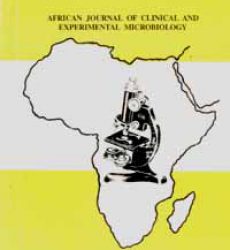Abstract
This study was aimed at evaluating the antimicrobial activity of Moringa on ear, nose and throat associated fungi and vancomycin resistant cocci. The plant material was extracted with methanol and petroleum ethe and screened for phytochemical contents. The microbial isolates were obtained from females and males patients (both adults and children) attending ear, nose and throat clinic at Aminu Kano Teaching Hospital. Coccal bacteria and fungi were isolated accordingly. The cocci were screened for vancomycin resistance. The antimicrobial assay was carried out using gradient double (12.5-100mg/mL) assay. The MIC, MBC/MFC and Brine shrimp toxicity test were also conducted. Staphylococcus aureus, Streptococcus pyogenes, Streptococcus pneumoniae, Candida albicans and Aspergillus fumigatus were isolated. Up to 21.4% of S. aureus were vancomycin resistant, 20% of S. pneumoniae isolated were vancomycin resistant and 16.7% S. pyogenes were vancomycin resistant. The plant extracts showed zones of inhibition of 08mm-20mm at concentrations ranging from 12.5-100mg/mL. The most susceptible organism to both extracts was C. albicans and the least susceptible was S. aureus. The MIC of the methanol extracts ranged from 0.78 to 50mg/mL but MBC/MFC ranged from 6.25 to 200mg/mL. The MIC of the petroleum ether was at 50 to 200mg/mL and the MBC/MFC was from 200 to 800mg/mL. The brine shrimp lethality assay showed LC50 value of 93.48μg/mL for Moringa methanol extract while the LC50 value for Moringa petroleum ether extract was 3.691μg/mL. Moringa methanol extract (100mg/mL), showed appreciable activity against the fungal isolates and vancomycin resistant cocci associated with Ear, Nose and Throat symptoms while Moringa petroleum ether extract showed activity only on the fungal isolate C. albicans. The study demonstrated that Moringa methanol extracts was more active than Moringa petroleum ether extracts. The search for novel cytotoxic ingredient in Moringa should be encouraged.
Keywords: Antimicrobial, Moringa, Ear, Nose, Throat, Fungi, Vancomycin, Resistant, Cocci
Download full journal in PDF below

